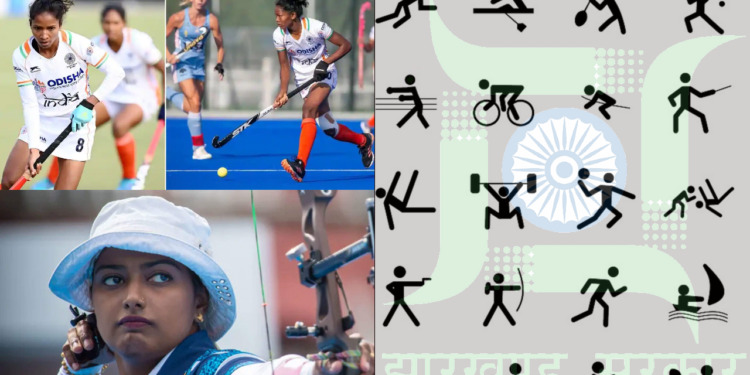Deepika Kumari, Nikki Pradhan and Salima Tete are the three state icons of Jharkhand now. They have been given this honour because they are the 3 out of more than 3.5 crore people of Jharkhand who went to represent India in the Tokyo Olympics 2020. Despite being known for its cricketing stalwarts like MS Dhoni, Varun Aaron and Saurav Tiwari, these Olympians have been chosen as official state icons. It is one of the rarest occasions that any athlete outside cricket has received deserving recognition in the state.
Despite its one-third of physically fit tribal population, Jharkhand sent only 3 Olympic athletes while Haryana and Punjab sent 31 and 14 respectively. Sure, it does come at 31st position at per capita GDP, but financing consists of a minute fraction of sporting achievement if the genetics are good. Jharkhand was constituted on 15 November 2000, after its bifurcation from its now neighbouring state of Bihar. Bordering Bihar, UP, Chhattisgarh, Orissa and West Bengal, and being rich in forests, area, Population Jharkhand alone can drive the sporting culture in six states of India.
Bihar was a state at the peak of its corruption during the 2000s. After the formation of Jharkhand, sporting bodies started to have more and more struggles for power for few years, though Jharkhand’s sports councils were better managed than Bihar’s, they still are nowhere close to utilizing the potential of their people. Jharkhand hosted 2011 national games where they were ranked 5th in the medal tally. Other than MS Dhoni’s name attached with Jharkhand, this was the only time it made blockbuster headlines on the sports level. Even Arunamishra’s 2004 world championship gold medal in boxing didn’t draw much attention of the officials towards the state of sports affairs in Jharkhand.
Jharkhand has a rich history of sports like Archery, Hockey, Kabaddi, Kho-Kho, Athletics, Boxing, and Football. The state even boasts of India’s oldest mountain climber Premlata Agarwal who achieved this feat at the age of 45. Deepika Kumari, Madhumita Kumari, Mangal Singh Champia, Purnima Mahato from archery, Aruna Mishra from boxing, Bimallakra, Birendra Singh Lakra, Jaipal Singh Mudra, and Sylvanus Dung from hockey are some famous players from Jharkhand.
In terms of sporting infrastructure facilities, JRD TATA Sports Complex hosts Indian Super League and is the home for Jamshedpur FC. Overall, Jharkhand has 16 good sporting facilities varying from international level to district level standards. Out of these 16, only a few in Ranchi and some corporate-led sports complexes in Jamshedpur can be called proper facilities, others are just mired by in-depth corruption and scandals.
Recent developments:
In October, 2020, the Jharkhand government appointed district sports officers for all 24 districts to boost the sporting culture in each district.
The Government has also promised to think on the long-standing demand of assurance of Government jobs for the athletes.
The Government has also announced to establish 30,000 village-level clubs with the aim to promote sports at grassroot level.
The road ahead: –
The corruption deep-seated inside the bureaucratic structure of SAI (Sports Authority of India) centres and sports governing bodies need to be eliminated by adopting a war-like strategy. Other than Ranchi and Jamshedpur, sports facilities anywhere are mostly breeding (sometimes literally) grounds for animals grazing. Players have to fight authorities, as well as poverty to excel, so most of them can’t be blamed for losing. Involving organizations like NYKS (Nehru Yuva Kendra Sangathan) could be the biggest game-changer in the state. Facilities for Hockey and Archery need to be upgraded as both these games are closest to the main tribal population of the state of Jharkhand.
In the end, either financial or criminally punitive steps need to be put in place if any case of misappropriation of funds or corruption is found. The state in which India is the captain of its first Gold Medal in the Olympics can certainly give a lot more if taken care of well.
